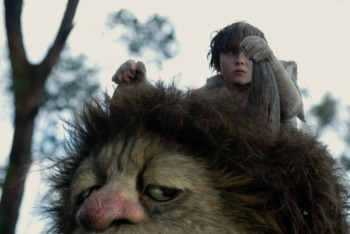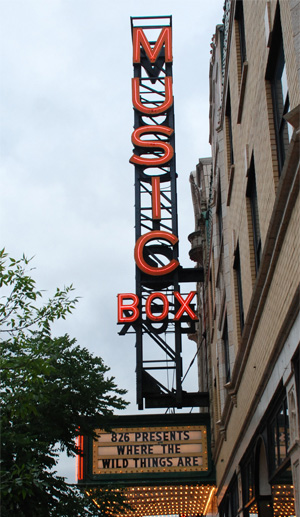REVIEW: Where The Wild Things Are
By Jake Guidry in Arts & Entertainment on Sep 30, 2009 5:30PM
 Maurice Sendak first picked Spike Jonze to direct Where The Wild Things Are after seeing Being John Malkovich, a movie Jonze directed a decade ago. Needless to say, the process it’s taken to transform Sendak’s beloved childrens book into a live action feature film has been long and tiring. And that’s just for the fans. We’ve threatened to eat our parents because of it. But, the wait will soon be over, and for Chicagoist, it already is.
Maurice Sendak first picked Spike Jonze to direct Where The Wild Things Are after seeing Being John Malkovich, a movie Jonze directed a decade ago. Needless to say, the process it’s taken to transform Sendak’s beloved childrens book into a live action feature film has been long and tiring. And that’s just for the fans. We’ve threatened to eat our parents because of it. But, the wait will soon be over, and for Chicagoist, it already is.
We were fortunate enough to see an early screening last night of Where The Wild Things Are at The Music Box on Southport that benefited host 826 Chicago and featured Q&A with Max Records, co-writer Dave Eggers, Catherine Keener, and director/writer Spike Jonze. The event had a good, positive vibe. However, we must discuss the movie.
The main sentiment heard when one brings up Jonze’s adaptation of Wild Things is he better not screw it up! While we feel this way about essentially every film adaptation that ever came from a book, with Sendak’s story, the feeling is deeper. Every boy felt as if Where The Wild Things Are was his book. Every girl felt the story was about her and her childhood. Damned be the man who tarnishes such a jewel of our childhood.
However, the real obstacle with adapting this book to film is that it’s less than ten sentences long. While we usually complain about omissions in film adaptations, it’s what’s been added that matters. The question is: did Eggers and Jonze meaningfully develop such a simple story, or does it float off into some other galaxy, barely representing what the book is all about? Settle those nerves, it’s the former.
 Eggers and Jonze have written a story that fully fleshes out the themes and undertones of Sendak’s book and gives it context within today’s culture. The film, like all the rumors have said, is often dark. It is also sometimes very fun and playful. However, these are the things that make up a childhood and Eggers and Jonze did not minimize the feelings every 9-year-old boy has. The film has a very clear message that is not over-the-top, preachy, or forced. It all feels very natural and genuine. There are several moments where we felt deeply connected to the characters. These moments nearly brought on tears. We’re not joking.
Eggers and Jonze have written a story that fully fleshes out the themes and undertones of Sendak’s book and gives it context within today’s culture. The film, like all the rumors have said, is often dark. It is also sometimes very fun and playful. However, these are the things that make up a childhood and Eggers and Jonze did not minimize the feelings every 9-year-old boy has. The film has a very clear message that is not over-the-top, preachy, or forced. It all feels very natural and genuine. There are several moments where we felt deeply connected to the characters. These moments nearly brought on tears. We’re not joking.
The emotionality of Jonze’s adaptation is the driving force of the film, and a huge part of that was his choice against CGI for the Wild Things (except for the facial expressions). CGI would have destroyed this film. The fact that the Wild Things look and seem real in both their appearance and movement is the chief reason we connected with them.
In the book, the Wild Things have no names or developed character. In the film, they are, and this is perhaps the most gratifying part. Jonze developed all the Wild Things to have sincere character traits, ones that are arguably manifestations of Max’s psyche (he is the one dreaming all of this). The highlight here is Carol, voiced by James Gandolfini. Gandolfini does an incredible job bringing this character to life and it is easily the most compelling part of Where The Wild Things Are. There are parts where Gandolfini had us so uneasy and legitimately worried for Max and the other Wild Things that it was difficult to watch, yet we couldn’t take our eyes off the screen. We’d be surprised if Gandolfini doesn’t take any hardware home for his performance.
The choice to shoot in Australia was another great one by Jonze and his team. It is a beautiful place that allows for the fantasy element to be brought in without being overdone. These places are real, after all. Long, wide shots of Max and Carol trekking the desert are beautiful and understated. “All this used to be rock,” Carol tells Max, “then it turned to sand, then it will turn to dust. I’m not sure what comes after dust.” It’s dark, indeed, but poignant nonetheless. It is moments like this that give much appreciated scope to Sendak’s story.
There’s not much to complain about with Where The Wild Things Are. Perhaps it’s too dark. Perhaps it doesn’t really offer a solution. Perhaps it’s too cryptic. But that’s how life is sometimes, and Jonze captures it wonderfully.
For our arbitrary rating, we give it 3.34 Hancock Towers out of 4.
Here’s some parts of the Q&A that we were able to get down:
Q: What were the challenges directing the Wild Things?
Jonze: If [the Wild Things] don’t like the direction, they eat you [laughter]. It was weird framing the shots due to the size of the Wild Things compared to Max. We also wanted to feel spontaneous and alone while shooting.
Q: How did you deal with the pressure of so many people looking to you to make it great?
Jonze: It was scary. I grew up with the book. Maurice’s work is special because it made me feel it was mine and that’s how everyone feels about it. But they gave me the flexibility to make it my own.
Q: How was it working with Dave Eggers?
Jonze: With what he’s done with 826 and for so many others, he has so much time and energy to give to other people. His attitude was that he loved the book and wanted to help me. I rented an apartment in San Francisco and he would come over every day, help write, leave to go work at 826, come back and write some more, maybe go back to 826 to tutor a class, then go home and write all night. He was very helpful.
Q: Who gets the costumes?
Jonze: They’re in my bed right now [laughter]. They made so many of the wolf suits that they gave away a lot of them. There were a lot of kids on the set and we gave them all wolf suits. On the last shot we heard noises and looked over and saw all the kids in the wolf suits, smashing up the set.
Q: What was the process for developing the character?
Jonze: Dave Eggers and I sat in a room for eight hours a day, maybe wrote for 20 minutes and talked about how we would do the movie for the rest. Somehow in that equation of eight hours with 20 minutes of writing we were able to develop the characters.